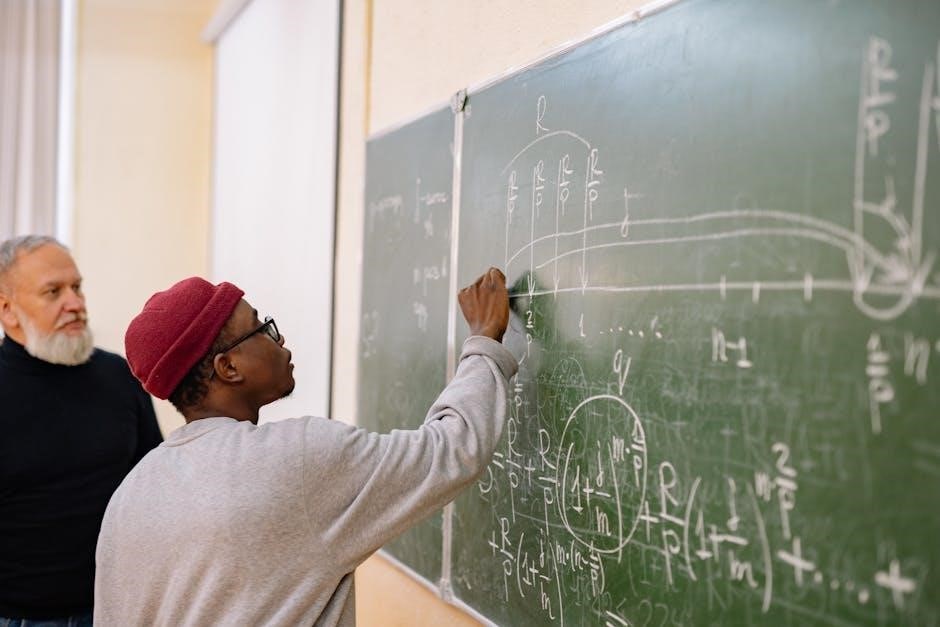Circle Theorem Questions and Answers PDF: A Comprehensive Guide
This guide provides a comprehensive collection of circle theorem questions and answers, perfect for GCSE and IGCSE exam preparation. It includes practice questions, solutions, and explanations of key theorems. You can also use this guide to revise the topic.
Circle theorems are fundamental geometric principles that describe the relationships between angles, lines, and arcs within a circle. Mastering these theorems is crucial for success in GCSE and IGCSE mathematics examinations. They provide the foundation for solving a wide range of geometry problems involving circles. Understanding the parts of a circle, such as the radius, diameter, chord, tangent, and circumference, is essential before delving into the theorems themselves.
This section will introduce you to the core concepts of circle geometry. We’ll explore how angles formed at the center and circumference of a circle relate to each other, as well as the properties of angles within the same segment. The cyclic quadrilateral theorem, which focuses on quadrilaterals inscribed in a circle, will also be discussed. Tangents and radii form unique relationships, which we will also examine. Finally, we will delve into the alternate segment theorem, completing the introductory overview.
Key Circle Theorems and Their Applications
This section delves into the essential circle theorems that form the backbone of circle geometry problem-solving. We’ll explore each theorem in detail, providing clear explanations and illustrative diagrams to aid understanding. Each theorem will be accompanied by examples demonstrating its practical application in various problem scenarios. We will also look at the relationships between: angles at the centre; angles on the circumference; Angles in the same segment; and cyclic quadrilaterals.
Understanding not only the theorems themselves, but also when and how to apply them, is crucial. We’ll focus on developing your ability to identify the relevant theorem for a given problem and use it effectively to find the solution. This involves recognizing key geometric configurations within the circle diagram and relating them to the corresponding theorem. Practice questions, with detailed solutions, will further reinforce your understanding and problem-solving skills. This section aims to equip you with the knowledge and confidence to tackle a wide range of circle theorem problems.
Angles at the Centre and Circumference
This section focuses on the fundamental circle theorem relating the angle subtended at the centre of a circle to the angle subtended at the circumference by the same arc. Specifically, the angle at the centre is twice the angle at the circumference when both angles are subtended by the same arc. This theorem is a cornerstone of circle geometry and frequently appears in exam questions.
We will explore this theorem through various examples and diagrams, ensuring a clear understanding of its application. Practice questions will be provided, ranging from simple calculations to more complex problem-solving scenarios. These questions will challenge you to identify situations where this theorem is applicable and to use it effectively to find unknown angles. Furthermore, we will consider scenarios where you may need to apply other circle theorems in conjunction with this one to arrive at the correct solution. By mastering this theorem, you will significantly enhance your ability to solve a wide range of circle geometry problems.

Angles in the Same Segment
This section delves into the theorem concerning angles subtended by the same arc (or chord) within the same segment of a circle. According to this theorem, angles subtended by the same arc in the same segment are equal. This principle is crucial for solving problems involving unknown angles within circles.

We will illustrate this theorem with clear diagrams and step-by-step examples, demonstrating how to identify angles that fall within the same segment and are therefore equal. Practice questions will include scenarios where you need to deduce the equality of angles based on their position within the circle. Some questions may require you to combine this theorem with other circle theorems or angle properties to find the required solution.
By working through these exercises, you will develop a strong intuition for identifying angles in the same segment and applying the theorem effectively. This skill is essential for success in circle geometry problems on GCSE and IGCSE exams.
Cyclic Quadrilaterals
A cyclic quadrilateral is a four-sided figure where all four vertices lie on the circumference of a circle. This section focuses on the specific angle properties of cyclic quadrilaterals and how to apply them to solve geometric problems.

The key theorem related to cyclic quadrilaterals is that the opposite angles of a cyclic quadrilateral are supplementary, meaning they add up to 180 degrees. We’ll explore this theorem in detail, providing visual aids and worked examples to illustrate its application. Questions will involve identifying cyclic quadrilaterals within diagrams and using the supplementary angle property to calculate unknown angles.
Furthermore, we will address questions that require you to combine this theorem with other circle theorems and angle relationships. Mastering the properties of cyclic quadrilaterals is important for tackling more complex circle geometry problems. The exercises in this section will help you develop the ability to recognize cyclic quadrilaterals quickly and use their properties effectively.
Tangents and Radii
This section is dedicated to exploring the relationship between tangents and radii in circles, a fundamental concept in circle geometry. A tangent is a line that touches the circle at only one point, called the point of tangency. A radius is a line segment connecting the center of the circle to any point on its circumference.
The key theorem we’ll focus on is that a tangent is always perpendicular to the radius at the point of tangency. This 90-degree angle is crucial for solving many problems involving tangents and radii. We’ll provide diagrams and examples to illustrate this theorem and demonstrate how to use it to find unknown angles and lengths.
Questions in this section will involve identifying tangents and radii in diagrams, applying the perpendicularity theorem to calculate angles, and using Pythagoras’ theorem or trigonometric ratios to find lengths when right-angled triangles are formed by the tangent, radius, and other line segments. Additionally, we’ll look at problems involving two tangents drawn from an external point to a circle, which are equal in length. Mastery of these concepts is essential for a strong foundation in circle theorems.
Alternate Segment Theorem

The Alternate Segment Theorem is a crucial concept in circle geometry, linking the angle between a tangent and a chord to the angle in the alternate segment. This theorem states that the angle between a tangent and a chord at the point of contact is equal to the angle in the alternate segment.
Understanding this theorem requires visualizing the ‘alternate segment,’ which is the segment of the circle that does not contain the angle between the tangent and chord. To effectively apply the Alternate Segment Theorem, it’s essential to correctly identify the tangent, chord, and the angles formed, along with the corresponding alternate segment.
This section offers clear diagrams and worked examples to help you grasp this theorem. Practice questions will challenge you to identify angles related by the Alternate Segment Theorem and calculate their measures. Problems may also involve combining this theorem with other circle theorems or geometric principles to solve more complex problems. The goal is to develop your proficiency in using the Alternate Segment Theorem to solve various circle geometry problems.
Practice Questions and Solutions
This section provides a comprehensive set of practice questions designed to test your understanding of circle theorems. Each question is carefully crafted to cover various aspects of the theorems, ranging from basic applications to more complex problem-solving scenarios. You’ll find questions involving angles at the center, angles in the same segment, cyclic quadrilaterals, tangents, radii, and the alternate segment theorem.
To maximize your learning, each question comes with a detailed solution. These solutions not only provide the correct answer but also explain the step-by-step reasoning and the specific theorems used to arrive at the solution. This approach will help you to understand the application of each theorem.
By working through these practice questions and studying the solutions, you can reinforce your knowledge, identify areas where you need further practice, and build confidence in your ability to solve circle theorem problems. This section is an invaluable resource for anyone preparing for exams or seeking to deepen their understanding of circle geometry.


